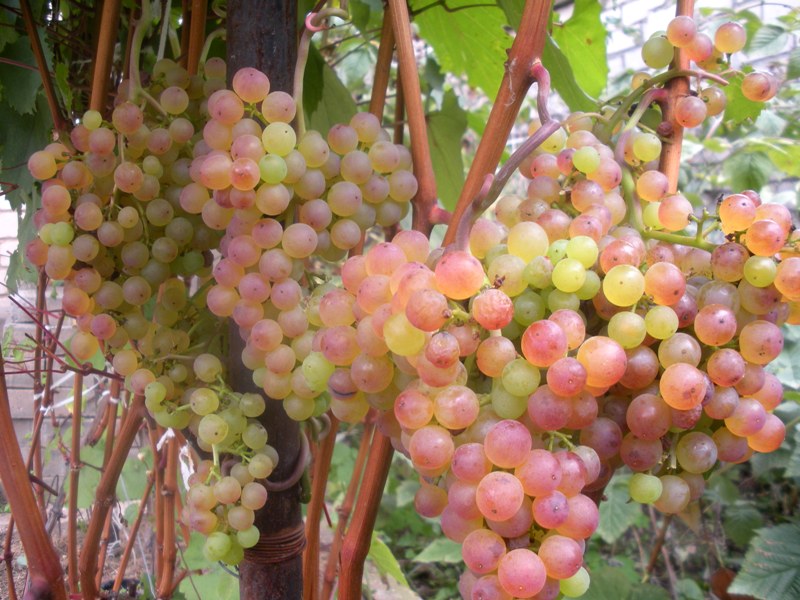
Grapes Korinka Russkaya - seedless variety with very early ripening. He is quite unpretentious in leaving, shows good yield, and the resulting clusters have excellent product data. Due to its merits, cinnamon stands out among varieties such as raisins and those that ripen very early.
Content
general description
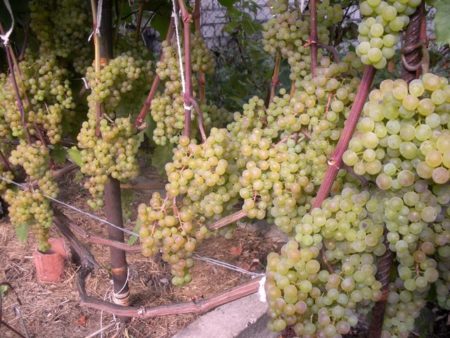
Korinka Russian was brought out by breeders from the Tambov region Filippenko I.M. and Shtin L.T., who skillfully crossed Kishmish Black and Dawn of the North. A distinctive feature of Korinka is its ultra-early yield. Ripe clusters begin to be harvested already in July, while berries of a larger mass of varieties are just starting to pour juice. The growing season lasts an average of 115 days. Korinka got a good immunity to diseases and good frost resistance from her parents. And although it is preferable to keep grapes in the central regions of the country in the winter under cover, summer residents note that the plant is able to tolerate frosts up to -25 degrees without harm to the crop.
The fruiting of the plant occurs in the third year after planting. Peak productivity varieties attributed to the age of 5-8 years. Then the yield drops slightly. You can improve the performance with the help of anti-aging pruning, when the shoots are very pruned.
Grade has a good survival rate. Cuttings are able to quickly root in almost any soil and on any stock.
Biological features of the variety
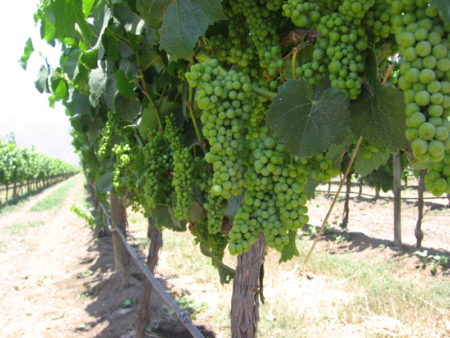
Grape Cinnamon Russian is an interminable plant; sometimes the height of the bush reaches three meters. The bush is very branched, it is characterized by the rapid growth of shoots, which have a high degree of maturation. The foliage is medium sized, dark green matte with yellow or light green veins, with slight pubescence. Five-lobed leaves, dissected.
On each shoot 2-3 small clusters are formed, weighing 200-300 grams. The brushes have the shape of a truncated cone, often winged. The average yield from one bush is 80 centners per hectare.
The plant has bisexual flowers, that is, they have male and female organs immediately, which means they can be pollinated independently, without the participation of bees.
The berries are round, they measure 1 * 1 centimeter. The skin is tight, of medium strength, it crunches when bitten. Its color is yellow-green, golden with a pinkish tan during biological ripeness. The pulp is dense, but juicy with a pleasant refreshing taste. The aroma characteristic of culture is absent. There are no seeds in the berries of the Cinnamon. Sugar content is 20-22%, the amount of acid is not more than 5 g / l.
Grade advantages:
The maternal couple awarded Kinkink with a number of advantages, including:
- almost 100% ripening of all shoots;
- the taste is the optimal combination of sugar acid;
- high productivity;
- universal purpose of berries (you can make wine or dry raisins);
- there are no peas in clusters;
- there are no seeds in the fruits;
- frost resistance is high, up to -25 degrees.
Disadvantages:
- low resistance to fungal diseases;
- susceptibility to flying insect attacks.
Growing Features
Cinnamon - grapes that you can grow both in open ground and in the greenhouse. This is especially true for territories located in the north of the country. Growing in sheltered ground, grapes bring the crop in mid-July. Due to its good survival rate and rapid growth of shoots, Corinka is suitable for cultivation in any region of the country. You can grow a fruiting bush from seeds, as well as vegetatively - from cuttings or seedlings. If you plan to plant seedlings, then it is better to give preference to annual bushes with a developed root system, which was constantly in a closed container. There should not be any foliage on the stems - only clean, moist wood of dark brown color with 2-3 eyes.
Grape seedlings are planted in separate deep pits, which are filled to the middle with a fertile loose mixture of turf, sand, peat, humus and minerals. Before planting, the roots on the trunks are cut, and after planting, the branches are shortened by a third. The trunk is set so that the roots look exclusively down. To achieve this with a small embankment in the center of the pit, along the slope of which the roots are straightened. After backfilling with earth, the top layer is compacted and the first watering is carried out.
Seedlings planted in the spring have time to root well in the fall, and the vine to mature. However, in the first year after planting, even in the southern regions, it is recommended to cover the bushes for the winter.
Care
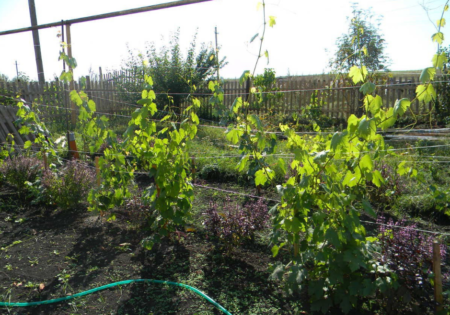
Cinnamon does not have special growing requirements. It grows well in the sun, but also feels comfortable in partial shade, and the yield in this case gives no worse than growing in a sunny area.
Watering
Grapes do not like too much moisture, so you should be careful with watering. On average, the vineyard is watered every 14-18 days. During flowering and fruiting, watering can be less common, otherwise excess moisture can adversely affect the integrity of the berry skin. After watering, the soil is loosened, while weeds are harvested, which can be sources of disease.
Pruning
Particular attention should be paid to the formation and pruning of the bush. Kinkinka is a vigorous, sweeping bush. It is preferable to grow it on a vertical trellis in a four-arm culture. The formation of the bush is carried out in the first two years - it is during this time that the main stem will grow fruitful vines. Together with pinching the shoots, it is necessary to unload the bush from extra clusters. It is necessary to leave no more than two clusters on one shoot.
Top dressing
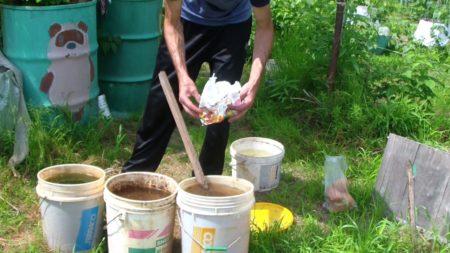
During the growing season, grapes are fed 3 times. For the first time fertilizers make in early spring. To increase the green mass at the end of April, nitrogen-containing compounds are introduced into the ground. This can be ammonium nitrate, urea, or organics - bred mullein, bird droppings, slurry. Before flowering, grapes need a portion of minerals, in particular phosphorus and potassium. This time they are feeding with superphosphate, potassium chloride. For the third time, the bushes are fed with the complex mineral composition necessary for filling the berries.
Protection against diseases and pests
Grade It is quite well protected from mildew and gray rot, but is susceptible to oidium disease. In addition, the sweetness of berries attracts hornets and wasps, which spoil the fruits and infect them with various kinds of infections. You can protect the grapes from the harmful effects of winged insects with the help of a net - it covers the ripening brushes of grapes. From the rodents, the bushes will be protected by the cultivation of the earth with Storm. Or you can scatter around the vine bushes poison for insects and mice.
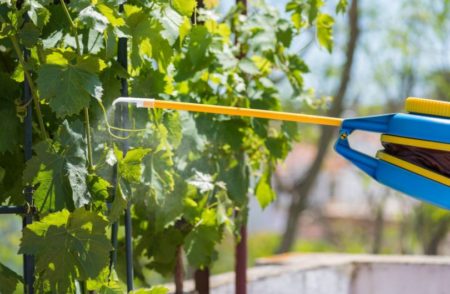
From infections in the early spring and autumn, preventive spraying is carried out with copper or iron sulfate.
Korinka's main enemy is the oidium.The fungus affects all parts of the plant, starting with foliage. At this time, the leaves begin to curl, and some shoots, mostly young ones, stop growing. Leaves on both sides are covered with a white dusty coating, in some places necrosis appears. Gradually, the disease spreads to flowers and fruits - they are also enveloped in a powdery whitish film. In the following stages, all affected areas darken, dry out and die.
The fight against the fungus is carried out in a comprehensive manner: they adjust the temperature and humidity, carry out agrotechnical measures (weeding, loosening, removing weeds), thin out the thickened areas, and remove heavily damaged branches and inflorescences. However, they begin to regularly spray with fungicides. Sulfur-based drugs (Cabrio Top) are particularly toxic to fungal infections. If the infection has already begun to spread, then the plants are treated with systemic agents, for example, Skor, Topaz, Rubigan. In the case when the oidium was already observed on landings in previous years, an early spring treatment is carried out by Hom, Horus, Strobi.
Reviews
Alexey
They say Korinka is an unpretentious variety. However, in the conditions of the Leningrad region, you need to try hard to grow a decent grape of this variety. Apparently he is not adapted to frequent rainfall. In conditions of high humidity constantly sick. In one place it rots, in another it is covered with brown dots, in the third the fruits are showered. Than I just did not spray it, not a single poison helps. As a result, he manages to give back the crop, but nothing comes of it there. In general, the variety, at least, is not suitable for me.
Nina
I have been growing Kinka for many years. At first there were problems with the grapes, then the wasps ate the fruits, then powdery mildew attacked. But then I adapted to the biology of the plant and all the problems resolved by themselves. I lead him into two long sleeves that extend along my fence. At four, it’s very difficult, since the shoots grow very quickly and grow woody, trimming them is troublesome. And so one lash goes in one direction, the other in the other. Grapes grow in the sun, waterlogging is excluded, since we have little rainfall in the summer. It is important to make mineral supplements. And not just potassium and phosphorus, but complex mineral fertilizers that grapes really like.
Conclusion
Despite the rather weak immunity, grade Russian Korinka is still quite widespread in Russia. He is also known in Poland, Belgium and Canada. They know about him in the Baltic states. The popularity is due to the universal appointment of berries, a quite good taste and the lack of special care requirements.




 Non-covering winter-hardy grape varieties for Moscow region
Non-covering winter-hardy grape varieties for Moscow region How to keep the vine in winter
How to keep the vine in winter When can I transfer grapes to another place in the fall
When can I transfer grapes to another place in the fall How to cover and prepare grapes for the winter in the suburbs
How to cover and prepare grapes for the winter in the suburbs